What is SAP MDG and What is SAP MDG used for?
SAP MDG tutorial: Overview or Introduction to SAP MDG
SAP MDG streamlines master data management to increase data quality, streamline business processes and enhance organization-wide productivity. Furthermore, MDG streamlines master data supply to minimize manual work and data inconsistency for maximum organization-wide productivity.
It manages master data efficiently for regulatory and organisational assent, creating audit trails and organizing master records with internal and external sources to guarantee current, actionable master information.
What is SAP MDG?
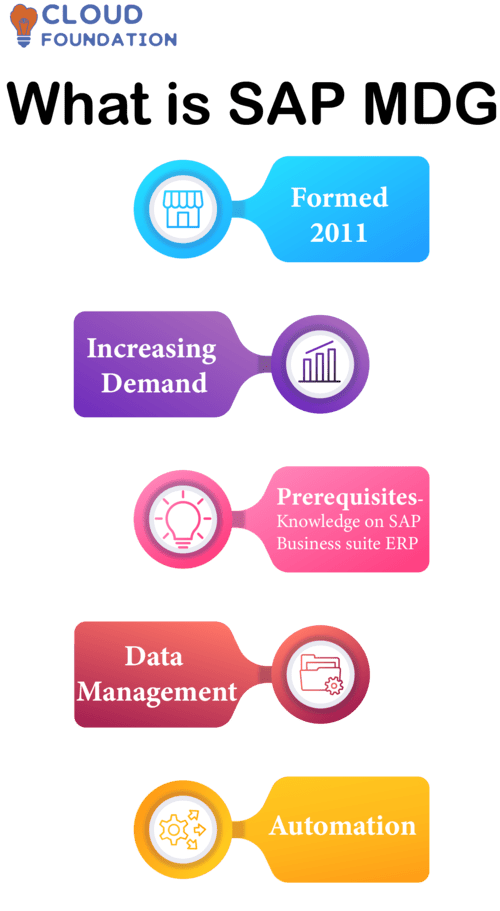
By maintaining consistent and up-to-date master data, organisations can streamline business processes, increase decision making capabilities, and meet analytical criteria more easily.
SAP Master Data Governance solution has also proven beneficial by automating duplicate data entry across remote systems to reduce costs and enhance reporting capabilities.
SAP MDG ensures only accurate and up-to-date information is communicated to businesses and individuals inside and outside your organisation, thus improving efficiency while decreasing human errors, improving audit scores and building credibility.
SAP MDG definition OR Define SAP MDG
Data management and user interface components are combined by SAP Master Data Governance to generate master data to be imported to host systems, while providing users the option of replicating all features and methods from both host system as well as client.
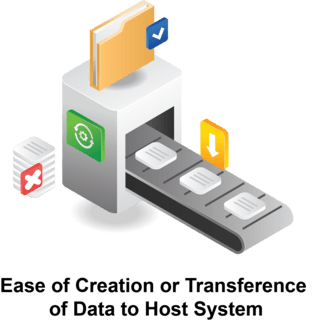
To build master data effectively SAP Master Data Governance provides users with all available ways for building them – mimicking them directly for ease of creation or transference to host system.
Private units provide an effective means of manipulating existing data without altering how public units send or receive it; each private unit may contain both additive and modificatory data elements.
Offset units are useful when data and units of similar nature, yet used differently, are being utilized. SAP MM includes this concept with their “High-Low Units.” They fill a different subrating unit while adding or changing data in order to differentiate one from the next.
What does SAP MDG do and what is SAP MDG used for?
What does SAP MDG do?
Master Data Governance provides businesses with a framework for effectively controlling all relevant business data within and without. This may include contact details, descriptions, and optional options like emails.
Facilitating system attribution and distribution becomes much simpler this way. Prompting or preventing duplicative data when creating messages also serves to manage it effectively.

Update conformity can be accomplished through manual or automatic control of data alteration operations, with this more effective data management approach reducing business decision failure risks due to outdated or duplicated data.
What is SAP MDG used for?
Use of standard data items and classification schemes can create enterprise consistency and coherence through guided data structures.
SAP systems strive for transparency and data quality improvements across their landscape, such as Business Suite, Management edition, Profitability, Customer interaction Retail Supply chain.
Focusing objects can assist SAP systems in creating order, integration and trust within them.
This result is marked by significant reductions in discrepancy, with more accurate, valid data with consistent definition, automated consolidation/deduplication mechanisms, as well as an additional master data check system aimed at real-time summary, completion, and verification throughout all business process steps.

Master data and quality at every point along its data cycle – onboarding to offboarding – create a trusted environment and centrally correct or confirm all parties’ requirements, while creating better, higher performing businesses with strong facts for decision-making purposes and giving actual business advantages to be realized.
SAP master data governance makes complex business changes simple, and is therefore considered an asset by businesses of any kind.
How does SAP MDG work?
Within its process-oriented workflow system lies SAP MDG which helps maintain master data, create/validate it as needed and ensure data consistency between systems.
SAP MDG begins by creating master data models for every entity (customers, vendors, materials).
The model will create process templates. Process templates provide data classification and management. They also facilitate master data creation/editing templates
Users may request changes to master data. Before any data changes can take place, requests must first be evaluated, reviewed and approved; to ensure it complies with master data model standards, MDG process template validation rules will also be enforced during validation.

SAP ERP system will receive and disseminate approved data to all connected systems for easy access; all master data remains consistent across systems.
SAP MDG can also analyze master data to identify trends and patterns, helping businesses make smarter decisions.
Why SAP MDG and what are the benefits of SAP MDG?
SAP MDG automates business procedures, data quality checks and organization-wide data consistency analysis for improved data quality, smooth operations, reduced training costs and enhanced decision-making resulting in increased productivity, efficiency and agility for organizations of any kind.
Benefits of SAP MDG

Utilizing an active rules engine for mapping, evaluating, and changing data.
Unify master data.
Effectively manage master and related data from inception through retirement.
Facilitates master data usage across transaction, analytical, and reporting business operations.
SAP and its network can use it as a central storage area.
Locating and merging related objects, such as duplicate Accounts Receivable data.
Manual and automated validation services verify addresses and payment terms.
Domain experts may use either manual or automatic validation methods.
An active SAP Rules Engine gives its user freedom in developing tests and assigning them to domain experts.
Advantages of SAP MDG
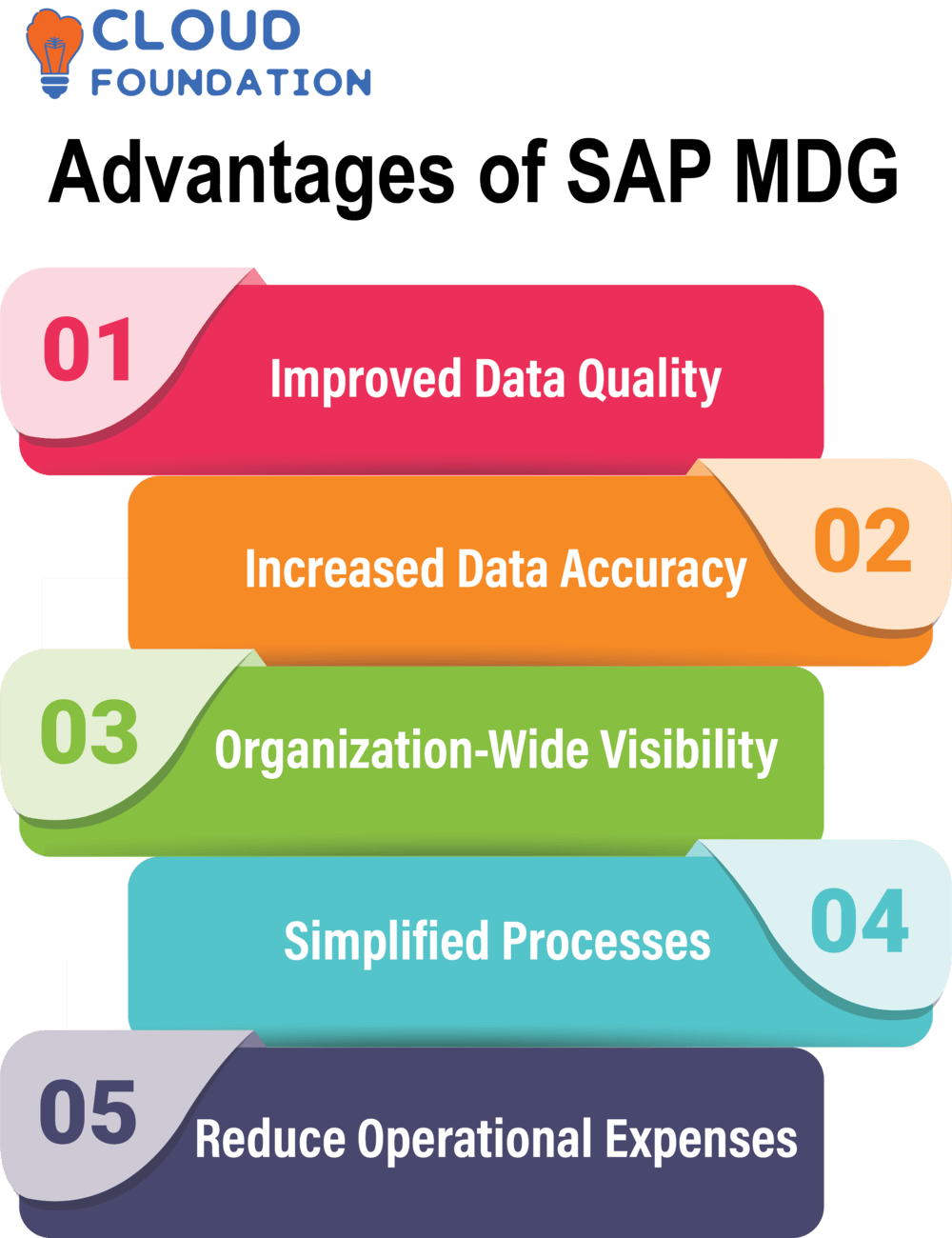
Improved Data Quality: It offers an easily managed central platform that monitors, verifies and ensures master data quality – centralizing object management processes while streamlining operational procedures and streamlining business.
Increased Data Accuracy: SAP MDG standardises and cleanses master data across organisational departments, guaranteeing decision-making based on precise, true-and-accurate information while upholding data governance quality across organisations.
Organization-Wide Visibility: It provides real-time data quality insights so users can make decisions based on current events.
Simplified processes: SAP MDG provides the foundation for streamlining master data operations by simplifying life cycle management of master data from creation through retirement.
Reduce Operational Expenses: Its automation eliminates manual processes, cutting operational expenses. By efficiently dispersing information across departments quickly and cost effectively, MDG saves both time and money on data administration efforts.
What is SAP MDG software and how to use MDG?
SAP MDG software facilitates hybrid clouds and heterogeneous devices while also permitting users to edit master data online.
Assuring business process and application data integrity, correctness, and control. Consolidating domain-specific master data across remote systems and applications.
Enabling global enterprise analytics with one single source of truth.SAP NetWeaver platform delivers effective global master data governance features.
The solution centrally creates, consolidates, approves, and shares master data among systems and contexts; quality assurance audit trail collaboration improves openness and accountability while the programme supports products material suppliers bill of materials pricing partner master data objects.
How to use SAP MDG?
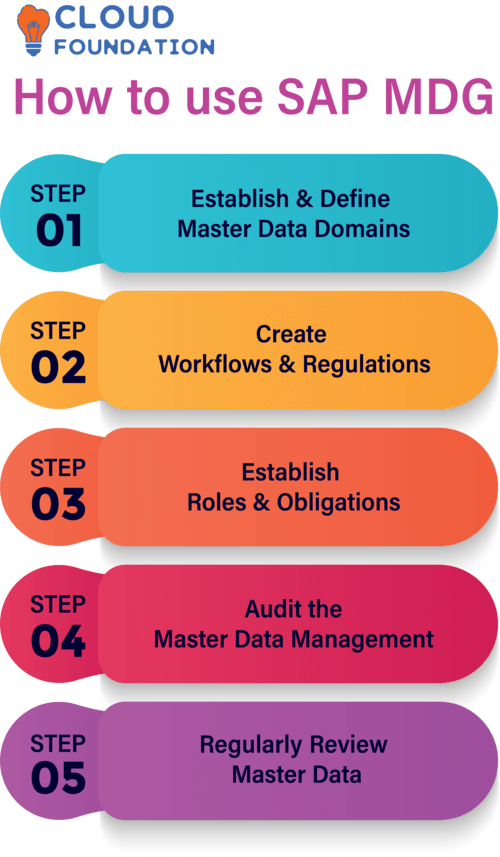
Establish and define master data domains: These domains organize related master data sets such as customer, product or financial account master data sets into manageable units of measurement.
Create Workflows and Regulations: Next, set in motion the necessary workflows and regulations required for master data domain governance, including roles and responsibilities, data entry/update rules, approval/audit processes as well as periodicity rules.
Establish Roles and Obligations: After creating procedures and regulations, assigning roles and obligations ensures everyone knows exactly their master data duties and expectations.
Audit the master data management process regularly in order to ensure consistency and data quality; analysis, profiling, and visualisation tools can assist.
Regularly review master data: Finally, it is imperative that organizations regularly assess whether their master data meets organizational needs or requires changes and updates.
Setting up and configuring the master data governance system correctly ensures data management efficiency.
Features of SAP MDG
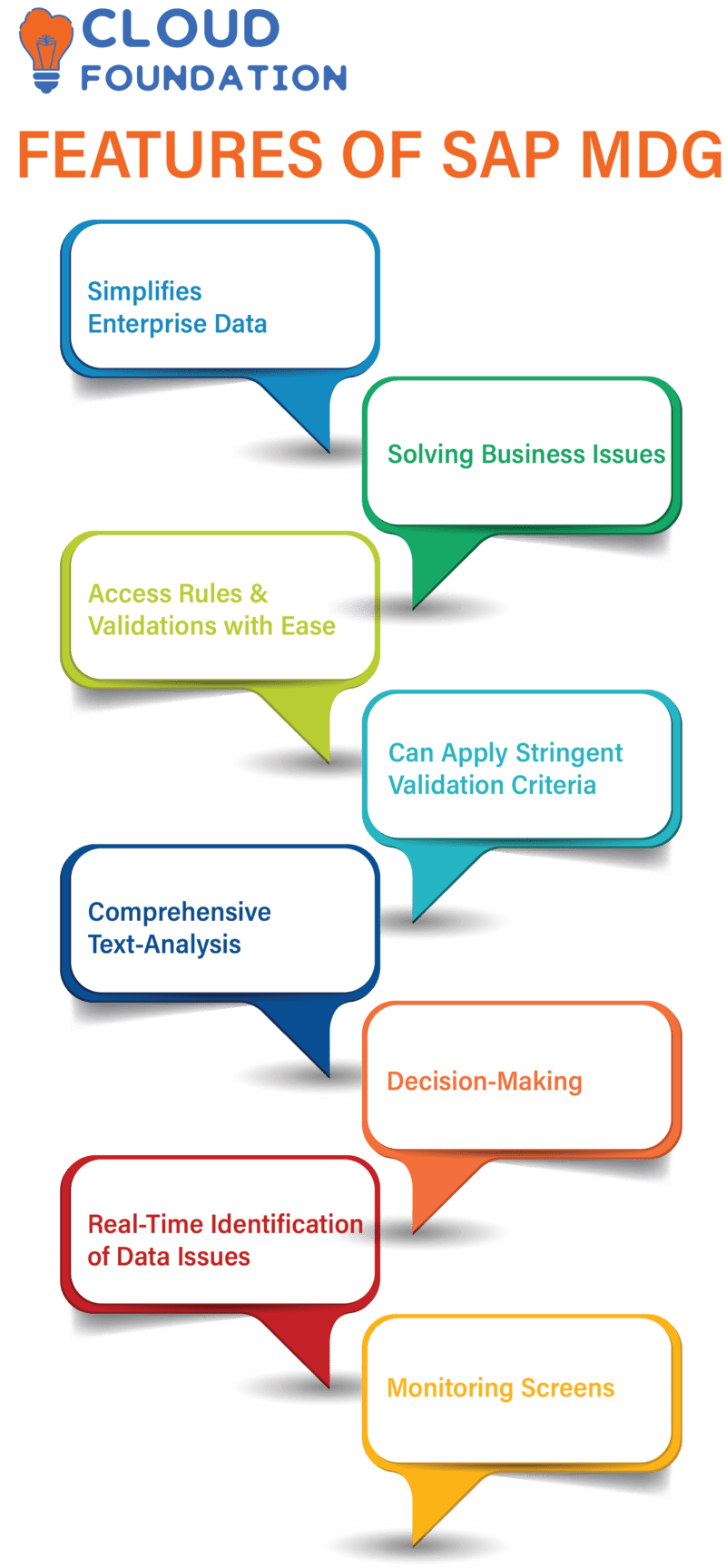
SAP MDG features include centralised governance that reduces quality risks while increasing complexity savings across ERP and CRM applications:
Master data governance provides you with a means of solving business issues and improving operations to increase data’s competitive advantage and maximize its competitive edge.
SAP MDG Role-Tailored User Interface Simplifies Enterprise Data Governance across your Organization
SAP MDG Use rules and validations, modify master data in our ERP, CRM, and other applications and access rules and validations with ease.
When adding, amending, or consolidating master data you can apply stringent validation criteria.
SAP MDG can be integrated with other data management and analytics solutions using entity analytics for comprehensive text-analysis.
Aid company decision-making with dashboards, analytics and data visualisation.
SAP MDG offers real-time identification of data issues, risks and fraud affecting an entire organization using all available information.
SAP MDG utilizes rules and validations for cross domain data, such as devices can only be modified via authorized ER Nets; monitoring screens provide visibility into any changes without authorisation; this audit trail also shows who changed what.
What is MDG in SAP? Or What is MDG SAP?
MDG streamlines data production, validation, approval and reporting by showing master data patterns such as scope of change and implementation speed.
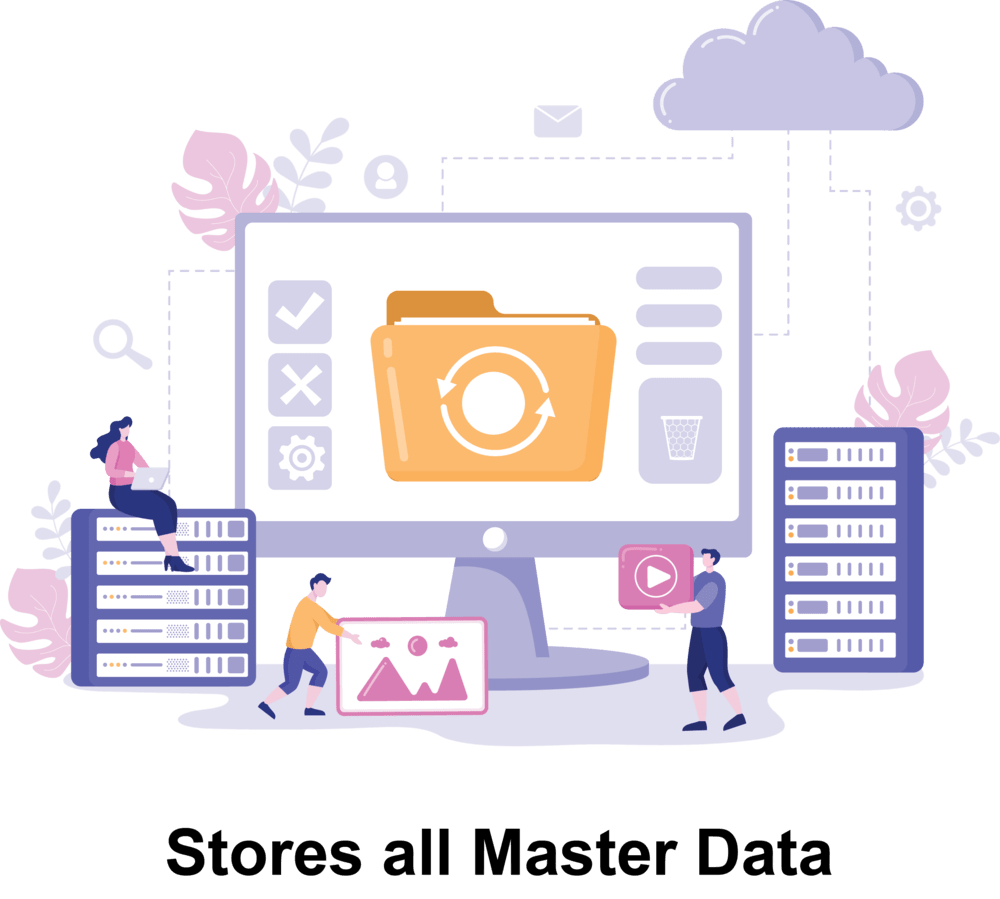
It stores all master data as well as corrects it reducing duplicate records while eliminating duplication altogether.
Master Data Hub streamlines and standardises master data creation and management across systems, guaranteeing data correctness and integrity for improved decision-making capabilities.
Through powerful technologies that ensure consistent master data is kept, organisations are better positioned for improved decision-making processes.
What is MDG finance?
MDG finance monitors site financial signs to provide more efficient management and transparency of finances, setting up accounts, phases and customs as necessary
SAP MDG harnesses data generated during master data generation to deliver forward-thinking insights for financial reporting beyond consolidation, helping decision-makers identify finance governance trends, cost allocation advantages and financial visibility benefits while simultaneously meeting legal standards.
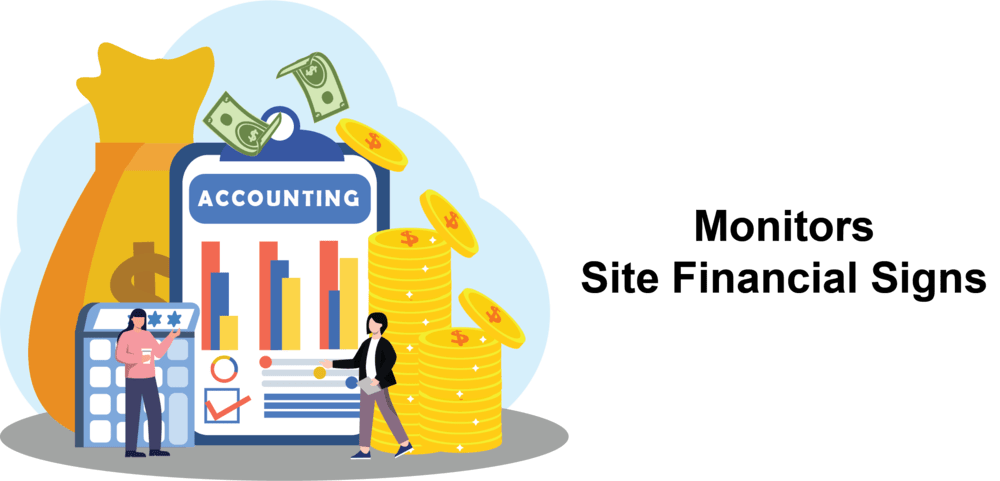
It places great emphasis on master data cleansing, consistency and completeness to enhance business processes and maximise benefits from financial reporting frameworks.
SAP MDG Finance uses master data generation to offer its clients an insightful view on financial reporting and investments into infrastructure for business operations such as consolidation, FIM management, AP automation and so forth.
How does MDG financing work?
Master Data Governance financing enables SAP Master Data Governance to set financial conditions and secrecy terms when customers accept sales or financing offers from SAP MDG financing packages, with these components potentially changing when customers accept or decline an offer for sales or financing from this package.
SAP Master Data Governance financial packaging sets terms and conditions upon acceptance or decline for these packages which validate financial terms such as due dates, discount cycles and any additional financial requirements which customers receive via contract documents.
What are the best ways to learn SAP MDG?
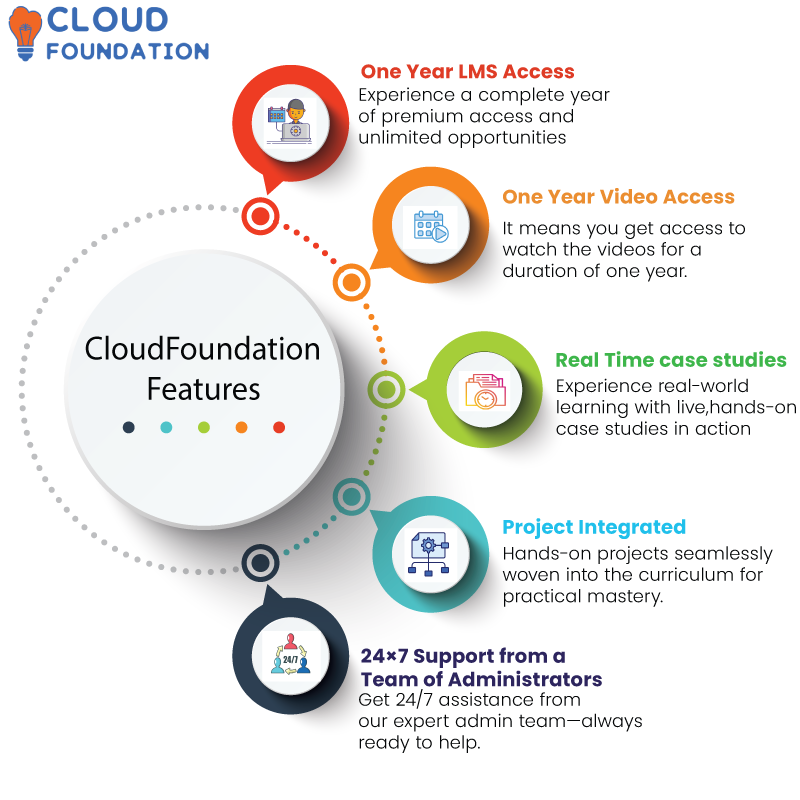
Here, real world knowledge can be combined with that gained in courses on this topic; SAP MDG training videos or SAP MDG blogs provide further assistance on SAP MDG basics.
By understanding these fundamentals of SAP MDG training, you may easily complete your SAP MDG course successfully and feel more at ease using it in subsequent projects.

Kiranmai
Author
“Bringing you the latest in tech news and insights to ignite your creativity & spark positive change – Welcome to my world of words”



